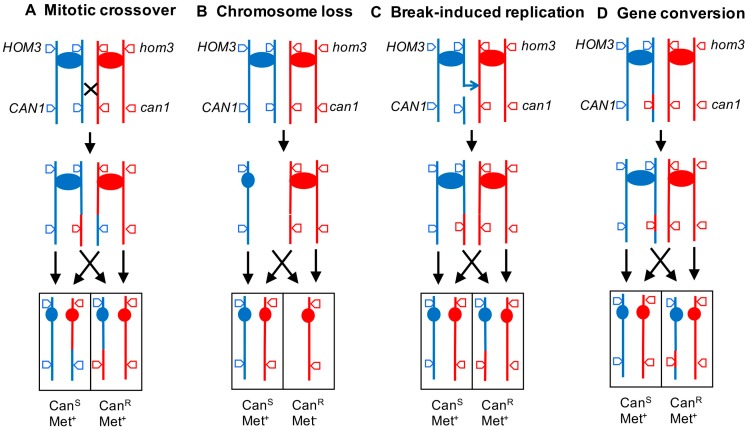Figure 1.
Mechanisms leading to loss of heterozygosity (LOH) in a diploid that is heterozygous for a can1 mutation. A commonly used assay in yeast to detect LOH involves a diploid that is heterozygous for can1 and hom3 mutations located on chromosome V. Strains that are heterozygous for the can1 mutation are sensitive to canavanine, and strains heterozygous for the hom3 mutation can grow in medium lacking methionine. The different line colors represent the two homologs, and the ovals show the centromeres. The events are depicted as occurring in cells after replication. (A) Mitotic crossover. A crossover between the can1 marker and the centromere can result in one cell that is homozygous of the can1 allele and another cell homozygous for the wild-type CAN1 allele. Both strains remain heterozygous for the hom3 allele. In the figure, we show the chromosome segregation pattern that results in LOH (indicated by four arrows). An equally frequent segregation pattern in which the recombinant chromatids segregate together will not result in LOH. (B) Chromosome loss. Loss of one of the blue chromatids results in one CanR product that is also Met-; the other product is identical to the original diploid. (C) Break-induced replication. In this mechanism, one blue chromatid is broken, and the acentric fragment is lost. The centromere-containing broken chromatid invades one of the red chromatids, copying its sequences from the point of invasion to the end. The CanR cell has the same phenotype as that produced by a crossover, but the event is non-reciprocal, and the other product is identical to the original diploid. (D) Gene conversion. A break in the blue chromatid is repaired using an internal segment of the red chromatid. This mechanism results in an interstitial LOH region.

